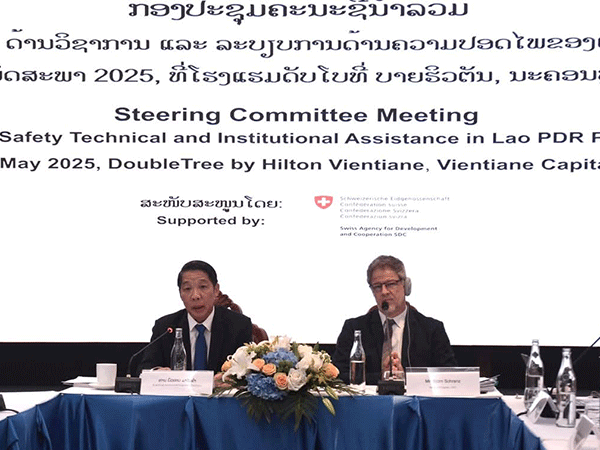Laos, Switzerland deepen partnership on dam safety
The governments of Laos and Switzerland have reaffirmed their commitment to enhancing dam safety in Laos through the Dam Safety Technical and Institutional Assistance project, when a steering committee endorsed the 2025 work plan.
This commitment was underlined at the project’s second steering committee meeting, which took place in Vientiane on Thursday.
 |
The department’s Director General, Mr Bouathep Malaykham, delivered his remarks at the meeting. |
The meeting was co-chaired by the Director General of the Department of Energy Industry Safety Management (DESM) under the Ministry of Energy and Mines (MEM), Mr Bouathep Malaykham, and Head of the Climate Change & Natural Resource Management Programme at the Swiss Agency for Development and Cooperation (SDC) in the Mekong region, Mr Björn Schranz.
Implemented by Helvetas with support from the Swiss Government and in close partnership with DESM/MEM, the National University of Laos, the Lao Association on Dams, and EDL-Gen, the Dam Safety Technical and Institutional Assistance project aims to strengthen institutional and technical capacities for dam safety across Laos.
Swiss experts contribute through technical assistance, knowledge exchange, and support for regulatory development.
The steering committee reviewed the key achievements of 2024 and officially endorsed the Dam Safety Technical and Institutional Assistance 2025 work plan.
This marks a continued commitment to bolstering dam safety standards, institutional effectiveness, and technical resilience in line with national and international best practices.
Mr Bouathep acknowledged the crucial role that dam safety technical and institutional assistance plays in building both technical and institutional capabilities within the Ministry of Energy and Mines and partner institutions.
He expressed sincere appreciation for Switzerland’s ongoing support and acknowledged the tangible progress achieved through this strategic cooperation.
Mr Schranz reaffirmed Switzerland’s long-standing partnership with Laos, saying that the Dam Safety Technical and Institutional Assistance project reflects a shared dedication to sustainable infrastructure, improved risk governance, and community safety.
He praised the value of Swiss expertise while emphasising the importance of Lao ownership to ensure long-term sustainability.
A key highlight of the meeting was the recognition of the launch of Laos’ first dam engineering course on February 13 this year.
Developed in partnership with the National University of Laos and Switzerland’s École Polytechnique Fédérale de Lausanne (EPFL), this milestone reflects the growing local capacity and shared investment in home-grown knowledge and resilience.
The steering committee adopted several recommendations to enhance project implementation, including strengthening cross-sectoral coordination, expanding capacity-building efforts to provincial and sectoral agencies, and promoting data transparency and information-sharing mechanisms.
The meeting also noted the upcoming Mid-Term Review by an independent third party, which will provide valuable insights to refine the project’s strategic direction and ensure alignment with Laos’ development priorities.
At the close of the meeting, Mr Bouathep underscored the importance of continued collaboration, legislative reform, and institutional strengthening to safeguard the communities and ecosystems that depend on hydropower.
At the same time, Mr Schranz reiterated Switzerland’s commitment to joint action, stressing that shared responsibility and co-creation are essential to maximising the project’s impact.
The meeting concluded with a strong sense of shared purpose and dedication to building a safer, more resilient dam safety framework in Laos, anchored in mutual respect, technical excellence, and a long-term development vision.
The Dam Safety Technical and Institutional Assistance project aims to improve dam safety across public institutions and academic sectors in Laos.
Financed by the SDC and implemented by Helvetas, the project contributes to the safety and well-being of approximately 1.5 million people by mitigating risks linked to dam failure or poor operational management.
By Times Reporters
(Latest Update May 9, 2025)
|


